The Economics and Statistics Division maintains archives of previous publications for accountability purposes, but makes no updates to keep these documents current with the latest data revisions from Statistics Canada. As a result, information in older documents may not be accurate. Please exercise caution when referring to older documents. For the latest information and historical data, please contact the individual listed to the right.
<--- Return to Archive
For additional information relating to this article, please contact:
November 07, 2024PROVINCIAL GDP BY INDUSTRY 2023 [REVISED] Statistics Canada released revised estimates of real GDP by industry for the provinces and territories in 2023. Real GDP growth is measured at the industry level with chained 2017 dollars at basic prices (sellers' prices before taxes less subsidies on products) that removes the effect of price changes.
2023 vs 2022
Nova Scotia's real GDP increased 2.1% in 2023, up from the preliminary estimate of 1.3%. Nationally, real GDP grew by 1.2% (unchanged from the preliminary estimate). All provinces except Newfoundland and Labrador reported rising real GDP in 2023. British Columbia reported the fastest gains.

Real GDP from goods industries was down 1.7% in Nova Scotia in 2023. Real GDP from goods industries was down 1.2% nationally with declines in six provinces. Saskatchewan reported the fastest increase in real GDP from goods industries in 2023 while Newfoundland and Labrador reported the steepest decline.
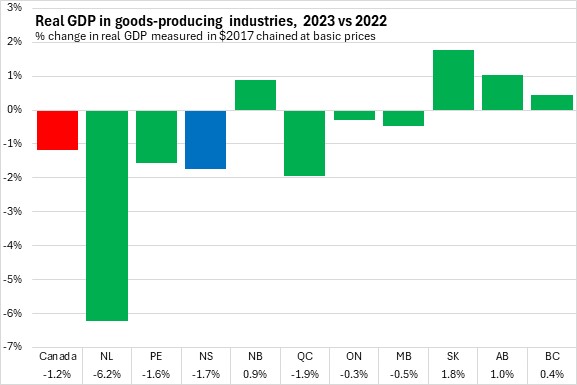
Nova Scotia's real GDP from services-producing industries was up 3.0% in 2023, faster than the national pace of 2.1%. Real GDP from services-producing industries was up for every province, led by Prince Edward Island and Alberta. Newfoundland and Labrador reported the slowest real GDP growth from services-producing industries.
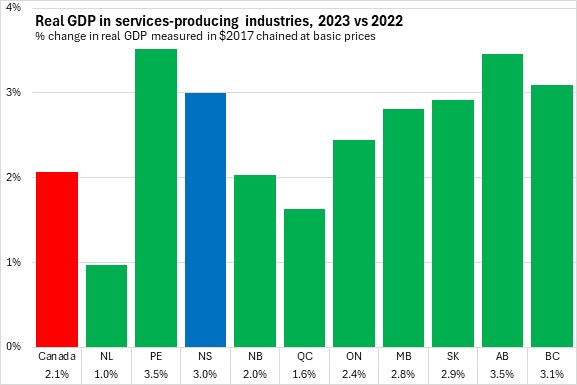
Nova Scotia's real GDP from public sector industries (which are a subcomponent of services-producing industries) was up 3.7% in 2023. Nationally, real GDP from the public sector also increased by 2.5% with gains in all provinces. British Columbia reported the fastest rise in real GDP from the public sector while Québec reported the slowest gain.
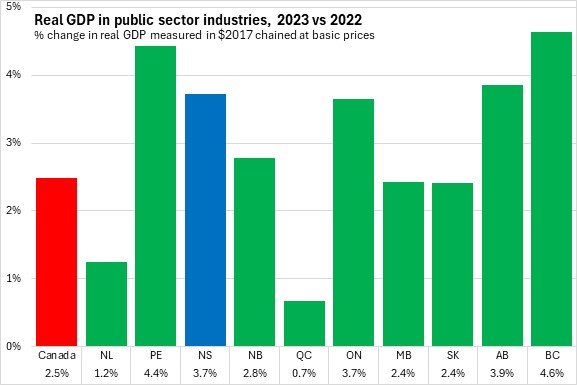
Trends
Nova Scotia's real GDP growth was distorted during the pandemic and recovery periods. Recovery continued for several industries in 2022, keeping Nova Scotia's real GDP growth elevated. In 2023, all provinces reported slower growth in real GDP compared to the year prior.
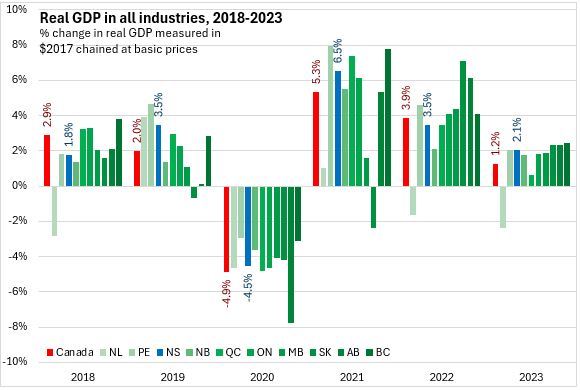
Nova Scotia's real GDP appears to be returning to pre-pandemic trends.
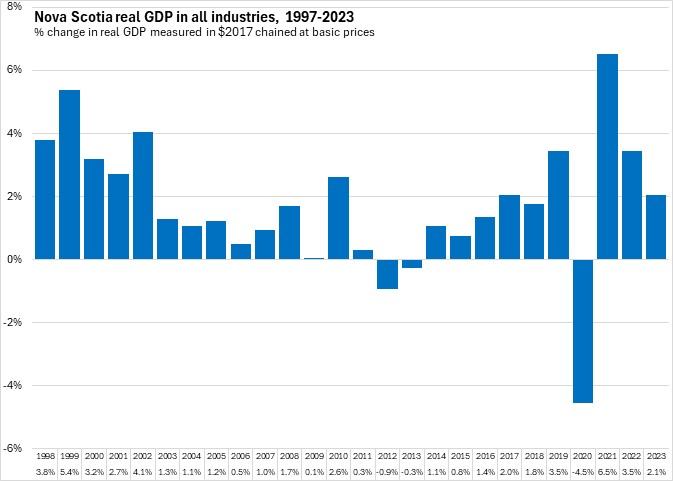

Real GDP per capita
With recent growth in population, real GDP per capita (a broad measure of material living standards) has declined. Nova Scotia has the lowest real GDP per capita among provinces. The Maritime provinces have the lowest real GDP per capita, followed by Manitoba and Québec. Saskatchewan and Alberta report the highest levels of real GDP per capita among provinces. Real GDP per capita is similar to the national average in Newfoundland and Labrador, Ontario and British Columbia.
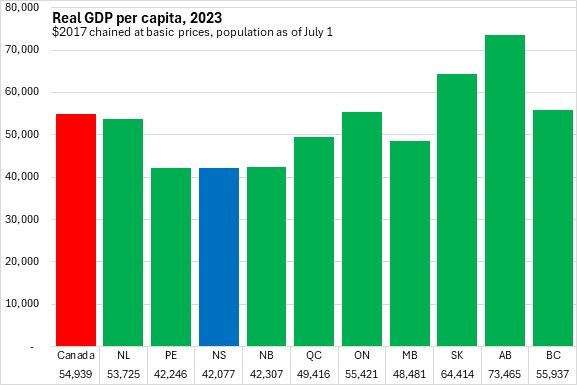
With population growth outpacing real GDP gains, real GDP per capita declined in all provinces in 2023. Nova Scotia's decline of 1.0% was slower than the national pace of 1.7%. Newfoundland and Labrador's real GDP per capita decline was steepest while Saskatchewan reported the mildest drop.
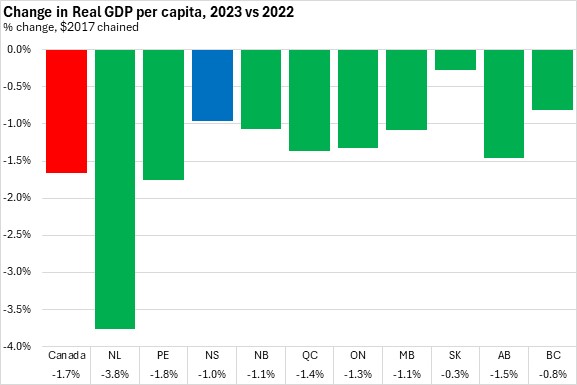
Over the last 10 years, Nova Scotia's real GDP per capita has increased by 4.6% - faster than the national average. British Columbia reported the fastest growth in real GDP per capita from 2014-2023, followed by Québec. Newfoundland and Labrador, Manitoba, Saskatchewan and Alberta reported declining real GDP per capita from 2014-2023.
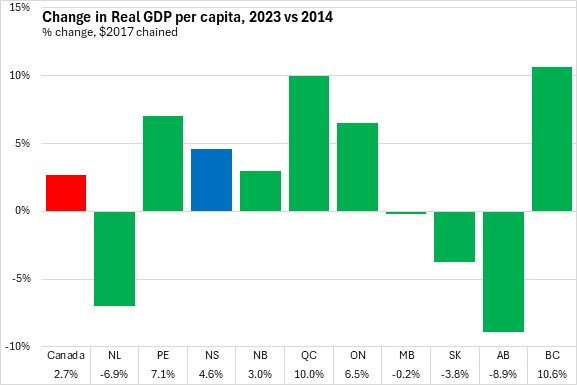
In the five years prior to 2002, Nova Scotia's real GDP per capita growth (compound average annual growth rate, CAGR) exceeded the national average. During this period, Nova Scotia's real GDP was expanding with new production facilities (natural gas, supercalendered paper). During the period 2002 to 2008, real GDP per capita growth was comparable with the national average. During the financial crisis and the years following (2008-2010), real GDP per capita grew faster in Nova Scotia (CAGR) than the national average, which declined during this time due to declines in resource producing provinces. As oil production in the west rebounded, Nova Scotia's real GDP declined with industrial closures (forest industry, petroleum refining) and lower real GDP from the Federal government. As recently as 2014-2019, Nova Scotia's real GDP per capita growth (on average) exceeded the national average. With the pandemic and recent population growth, real GDP per capita has declined or showed muted growth in most provinces.
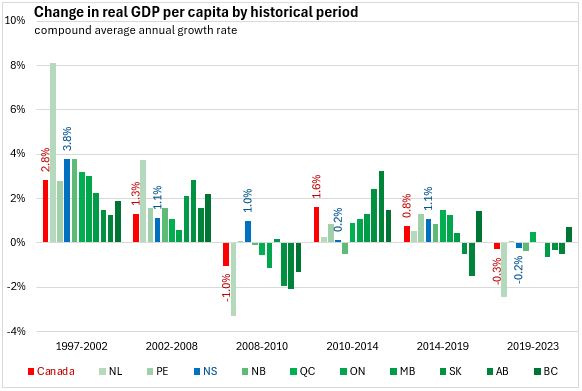
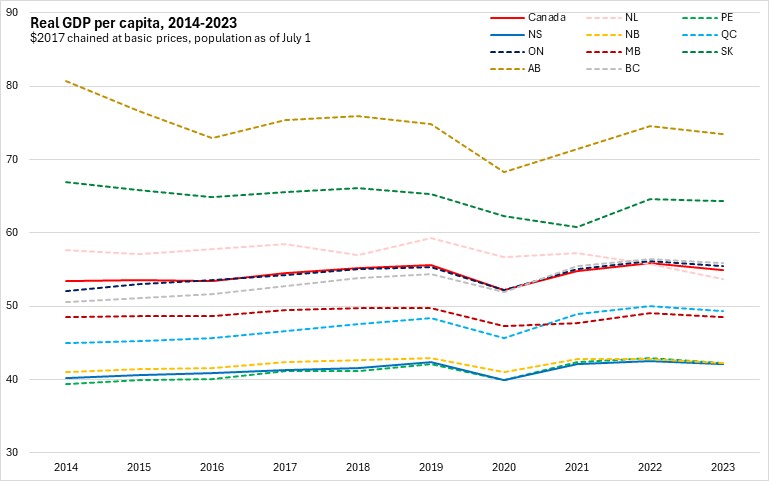
Nova Scotia GDP by industry
In 2023, goods production accounted for just under 19% of Nova Scotia's GDP while largely-private service producing industries accounted for just over 51% of Nova Scotia's GDP. Largely-public services (health, education, public administration) accounted for 30% of Nova Scotia's GDP.

The fastest growing industries in Nova Scotia's economy in 2023 were arts/entertainment/recreation, transportation and health care/social assistance. Although mining, oil and gas along with company management reported the largest declines in real GDP, these two industries are relatively small. Among larger industries, agriculture/forestry/fishing, construction and wholesale trade reported the sharpest real GDP declines in 2023.
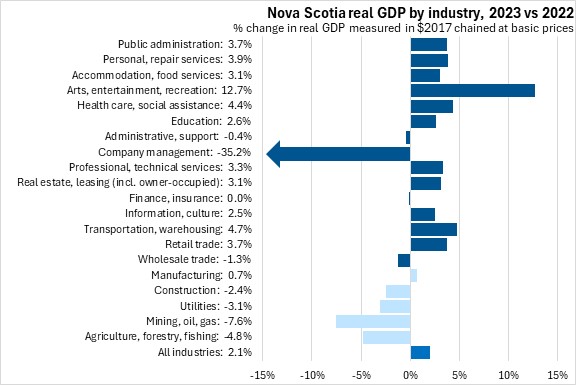
Based on size as well as change, real estate (including imputed rental GDP from owner-occupied dwellings) made the largest positive contribution to Nova Scotia's real GDP growth in 2023. This was followed by public administration, health care/social assistance (including daycare) and retail trade. The largest downward pressures on Nova Scotia's real GDP in 2023 came from construction and agriculture/forestry/fishing.
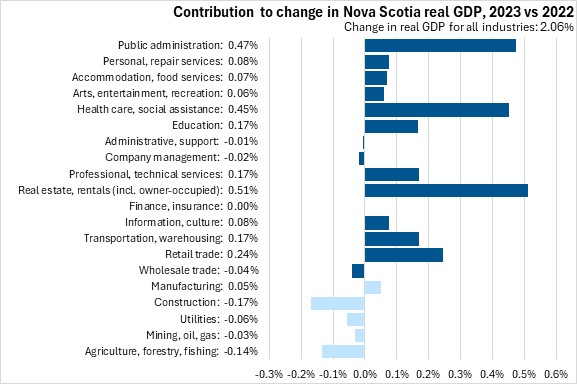
Real GDP for most resource-harvesting industries were down in 2023, with aquaculture, cannabis, forestry/logging ad mining/quarrying reporting the steepest declines. Support activities for forestry as well as oil and gas reported the strongest growth among resource extraction industries.
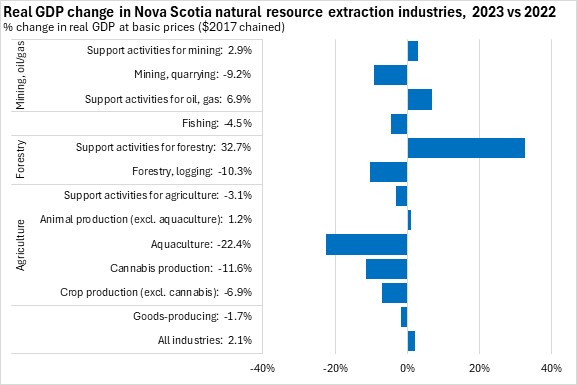
Nova Scotia's utility real GDP was down for electric power and up for water/sewage and natural gas distribution. Among construction industries, real GDP from residential construction (the largest construction industry) was down 8.9% while there was a 12.3% rise in non-residential construction real GDP.
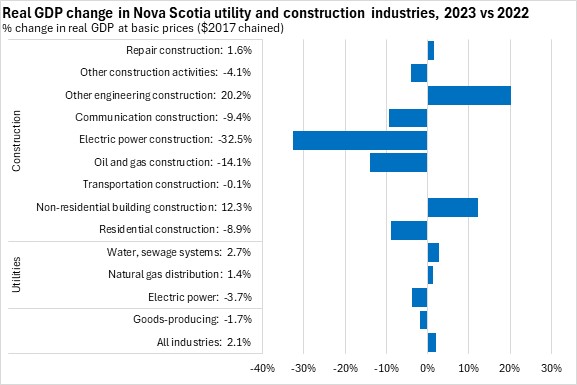
Real GDP was down in 2023 for most of Nova Scotia's food and beverage manufacturing industries - with the exceptions of animal foods, meat products and breweries. Sugar/confectionary and fruit/vegetable manufacturing reported the steepest declines.
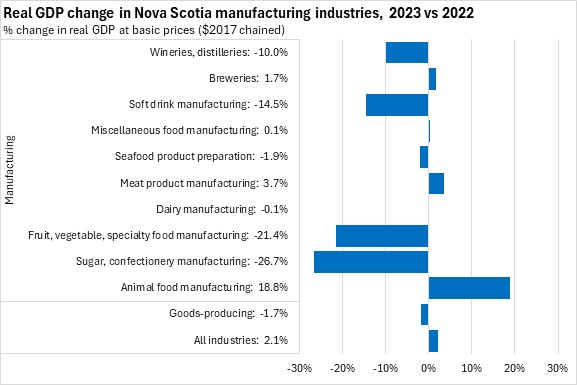
Lumber, petroleum/coal products, resin/synthetic rubber, and pesticide/fertilizers all reported rising real GDP in 2023. There were notable declines in real GDP from Nova Scotia's basic chemicals, paper, printing, textiles, clothing and rubber product manufacturing industries last year.
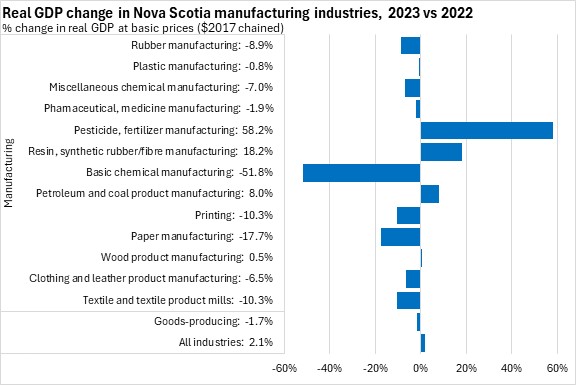
Real GDP increased for Nova Scotia's computers, electronics and metal products manufacturers. Real GDP was up for motor vehicle/parts, machinery, and furniture manufacturers. Real GDP was down for aerospace/parts, shipbuilding, and non-metallic mineral products in Nova Scotia in 2023.

Both wholesalers and retailers in food and beverage distribution reported declining real GDP in 2023. Health and personal care products reported the fastest gains in both wholesale and retail store real GDP.
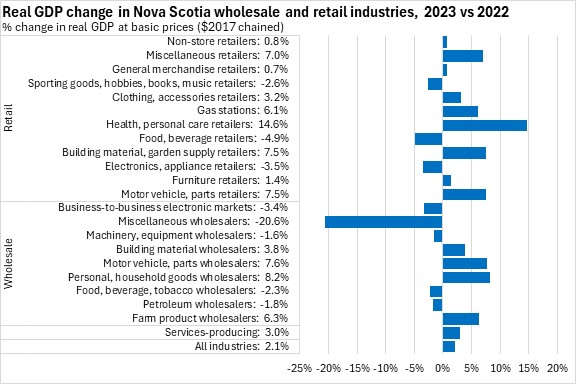
In transportation, there were notable gains in real GDP from transit/taxi/sightseeing as well as air travel. In information/culture industries, software publishing and motion picture exhibition posted large gains in real GDP. There were notable declines in real GDP from Nova Scotia's sound recording and data processing/hosting industries in 2023.
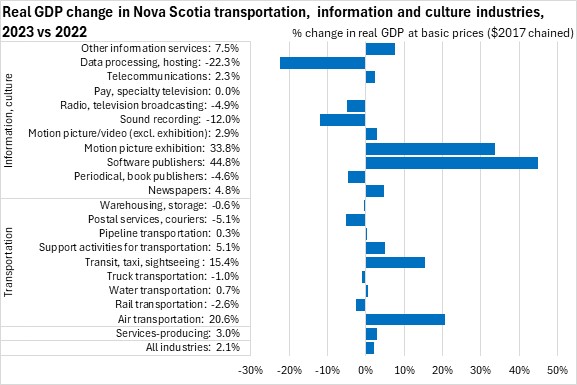
Banking posted a small increase in real GDP in 2023 in Nova Scotia, while investment services/funds declined. Although the imputed value of real GDP generated by owner-occupied dwellings was up 3.0%, real GDP from real estate agents contracted significantly.
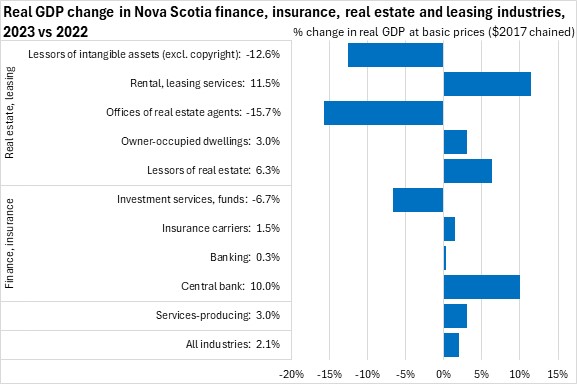
Real GDP from company management posted a substantial decline in 2023 (though this can includes reclassification of activities into different industries). There was real GDP growth across all major professional and technical services industries in 2023, led by architecture/engineering. In administrative/support industries (which includes call centres) there was a notable rise in real GDP from investigation/security services.
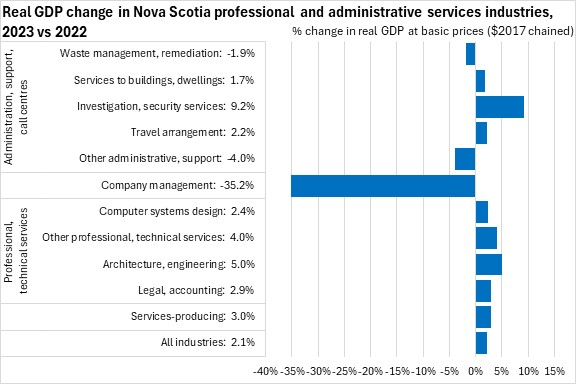
High-contact service industries continue to report strong growth in 2023, following major contraction in 2020 and recovery in the next three years. Amusement and recreation services along with performing arts and spectator sports posted the strongest gains.
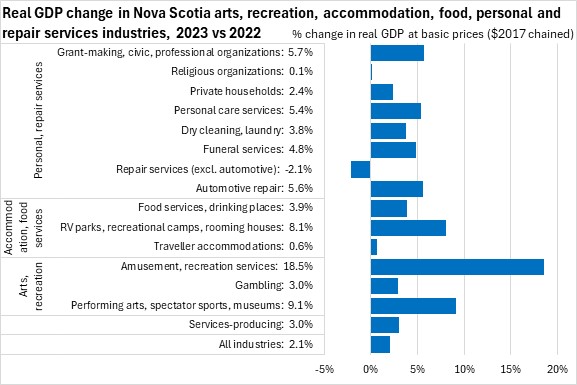
Health, education and public administration industries all reported rising real GDP in 2023. Aboriginal government, social services (including daycares) and hospitals reported the fastest gains.
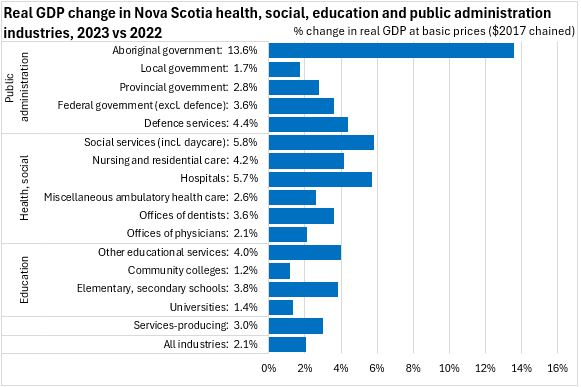
Trends in Nova Scotia real GDP by industry
In the 27 years of data from 1997 to 2023, there have been notable changes in the real GDP generated by specific industries. These charts show the value of real GDP from 1997-2023 for most industries in the Nova Scotia economy. Real GDP is measured in 2017 (chained) dollars at basic prices. Changes in the level of real GDP for each industry indicate how its real output has changed, absent the effects of changes in output prices.
Nova Scotia's real GDP grew more rapidly from 1997-2002 as new production facilities (natural gas, supercalendered paper) were built and brought into production. Real GDP growth slowed, but remained largely positive from 2002-2011. In 2012 and 2013, Nova Scotia's real GDP contracted with industrial closures in forest products and petroleum refining as well as reductions in real GDP from the Federal government. Growth started to accelerate again from 2014 to 2019 before the contractions of the first waves of COVID-19 in 2020. Nova Scotia's real GDP rebounded quickly from the COVID recession of 2020 with stronger growth in both 2021 and 2022 before returning to more modest growth in 2023.
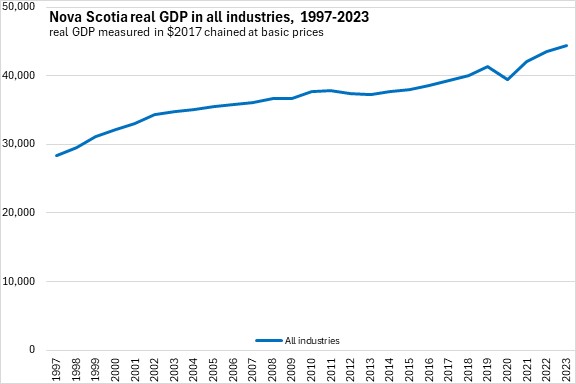
Real GDP from Nova Scotia's goods producing industries peaked in the early 2000s and trended down over the next ten years. Part of this contraction was due to slowing natural gas production as peak output on initial production is ordinary for this industry. Real GDP from Nova Scotia's goods-producing industries started to recover prior to the pandemic, but there was a contraction in 2020 (including the end of wood pulp production). Nova Scotia's goods industry real GDP rebounded in 2021 and 2022 before contracting once again in 2023.
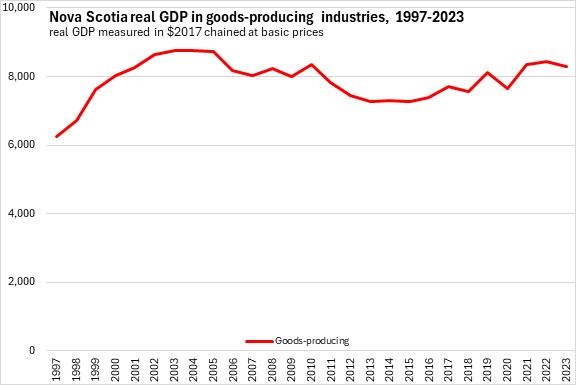
Nova Scotia's real GDP from agricultural industries has grown largely on rising cannabis production (this estimate includes illicit production). Although there are intermittent periods of faster growth and decline, real GDP from non-cannabis crops has grown slowly while real GDP from animal production has trended down.
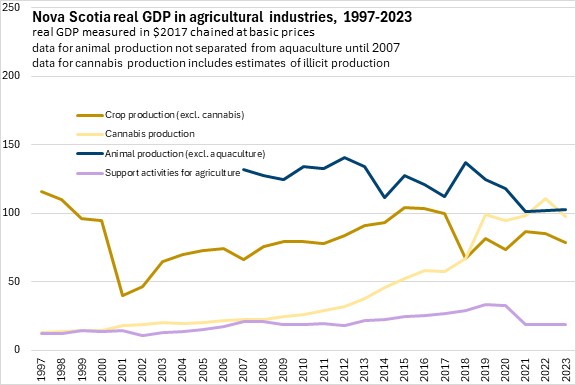
Real GDP from Nova Scotia's fishing and seafood industries has declined in recent years, despite rising export values. Although the volume of output has been lower, these industries have benefited from higher prices in more diverse markets.
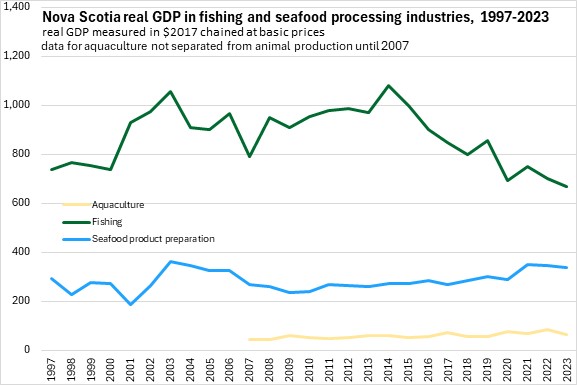
Nova Scotia's forestry and forest product industries have experienced substantial declines in recent decades, particularly with closures of paper production in 2012 and pulp production in 2020. Although real GDP from forestry declined, lumber production volumes increased from 2017 to 2021 before contracting in 2022 (with little change in 2023).
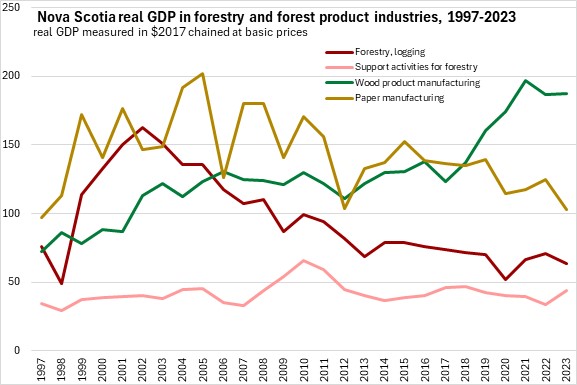
Nova Scotia's oil and gas output peaked in the early 2000s and ended by 2019. Mining and quarrying real GDP declined through 2013, but started to grow again from 2013-2020 before contracting again in the last four years.
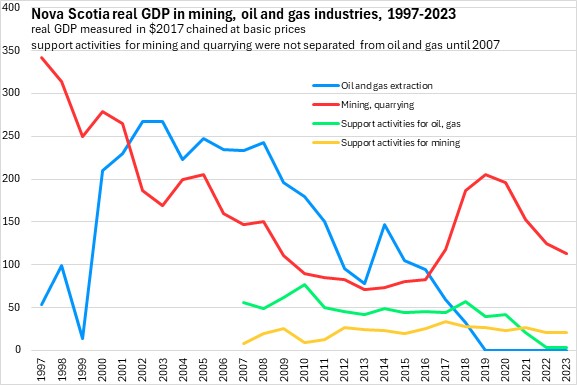
Nova Scotia's real GDP from electric power peaked in 2002 and declined over the next decade. There was a recovery in electric power real GDP through the pandemic, with a decline in 2023.
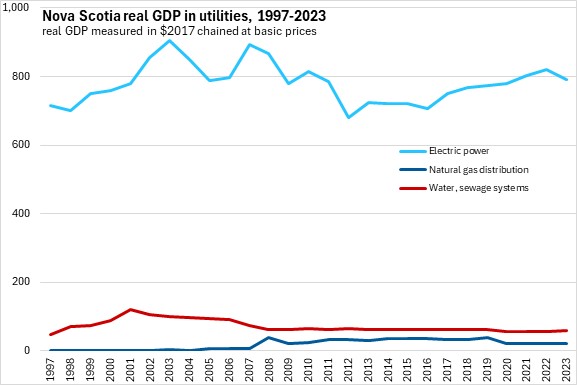
Nova Scotia's real GDP in construction industries has been led by gains in residential building, transportation construction and repair construction. Real GDP from engineering construction such as electric power, oil and gas and communications exhibit periodic spikes associated with large projects.
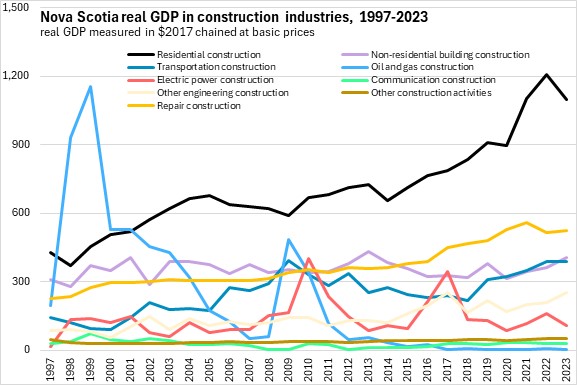
Within Nova Scotia's (non-seafood) food manufacturers, real GDP has been dominated by miscellaneous categories, which include bakeries. Most other food manufacturing industries have relatively small real GDP.
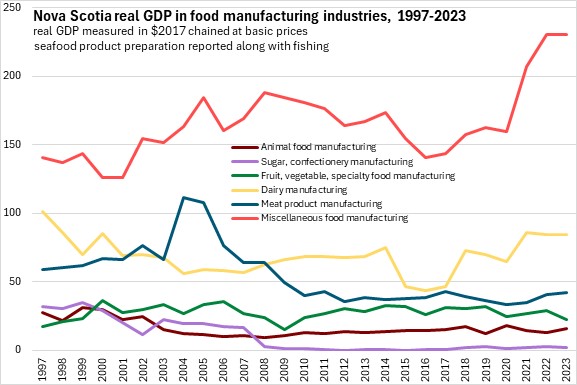
Real GDP from Nova Scotia's beverage and tobacco industries is notably smaller than from many other industries. Until 2023, there has been a notable rise in real GDP from wineries and distilleries. From 2014 to 2023, there was a notable recovery in real GDP from breweries. There has been a rise in tobacco product manufacturing in Nova Scotia since 2020.
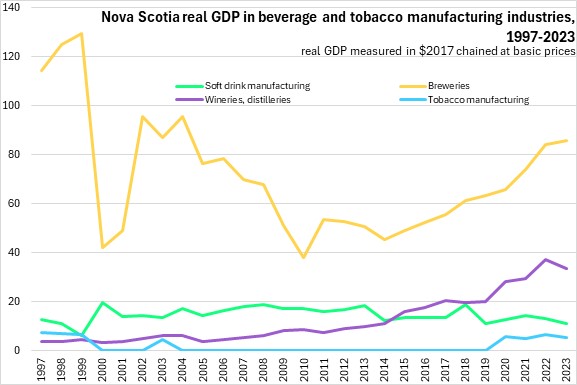
Nova Scotia's textile product mills reported a sharp decline in output in 2009. Clothing and leather product manufacturing real GDP has been trending down (though there were gains in 2022).
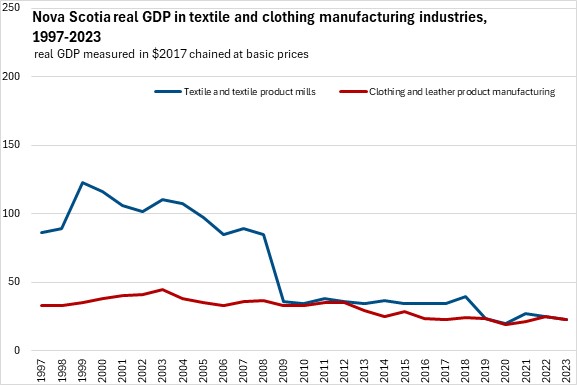
With the closure of the Dartmouth refinery in 2013, Nova Scotia's real GDP from petroleum product manufacturing fell to zero (it had been contracting for several years before that). There has been a steady increase in real GDP from Nova Scotia's pharmaceutical and medicine manufacturers, though this industry declined in 2023.
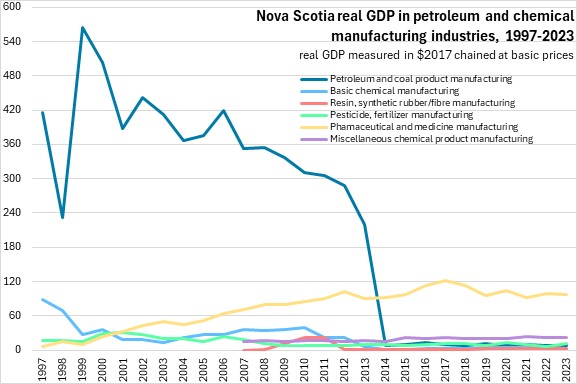
Real GDP from rubber products has exhibited significant increases and declines over the last 26 years. There has been an upward trend in GDP from rubber product manufacturing since 2006 (interrupted by declines and rebounds). In recent years, there have also been increases in real GDP from plastics manufacturers and fabricated metal product manufacturers (in particular in 2022 and 2023). Non-metallic mineral product manufacturers (including concrete) rose from 2019-2022 before contracting in 2023.
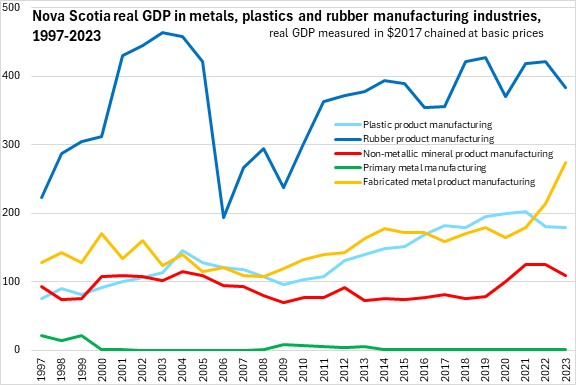
Nova Scotia's computer and electronic product manufacturers experienced declining real GDP from 2006-2017, but have rebounded in the years since then.
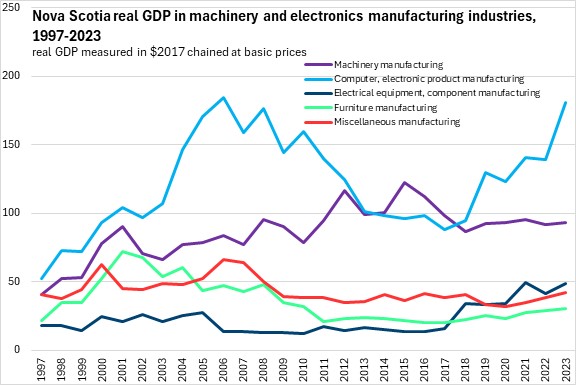
Nova Scotia's ship and boat building real GDP has grown substantially since 2008 while Nova Scotia's aerospace/parts producers have trended down since 2010.
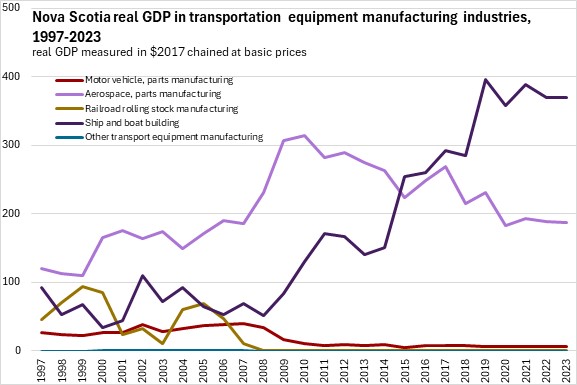
Real GDP from Nova Scotia's services-producing industries (including public sector) has risen steadily in most years with the exception of 2020.
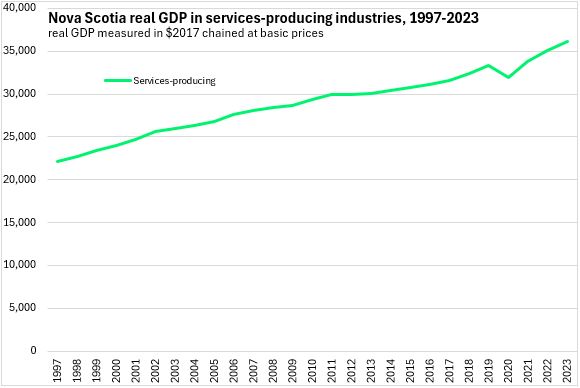
Within wholesale trade by industry (only available since 2007), real GDP has grown more rapidly in recent years for machinery/equipment wholesalers as well as miscellaneous wholesalers. There has been a sharp contraction in food/beverage/tobacco wholesalers in the last two years.
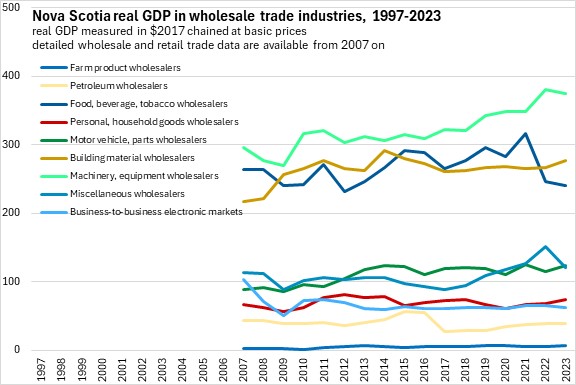
In retail trade, recent real GDP growth for food/beverage stores has eroded over the last two years. Motor vehicles/parts dealers have experienced volatile real GDP since 2017. There has been recent increases in real GDP from health/personal care stores, gas stations and building materials/garden supply retailers.
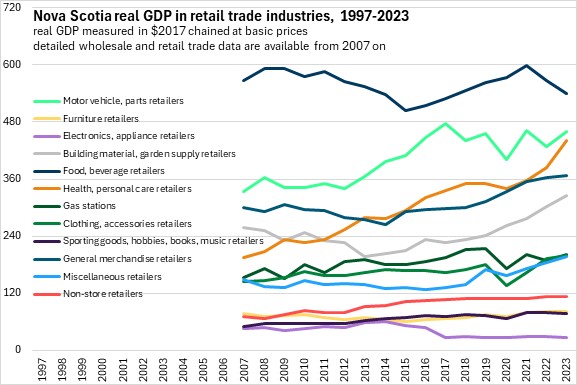
Transportation industries exhibited sharp declines during periods of pandemic-related restrictions (with the exception of postal/couriers, and warehousing). The declines and rebounds were particularly acute for air transportation as well as for support activities for transportation. Real GDP from truck transportation rose substantially from 2004-2017 but has levelled off since then. Postal service and courier real GDP has resumed its downward trend in Nova Scotia.
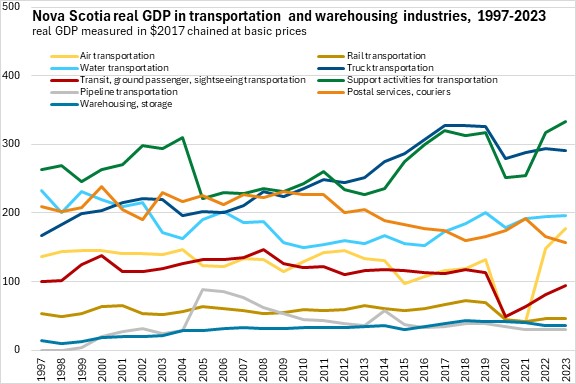
Telecommunications industries are by far the largest portion of Nova Scotia's information and cultural industries. With the exception of 2020, there has been steady and substantial growth in Nova Scotia's telecommunications real GDP since 2014.
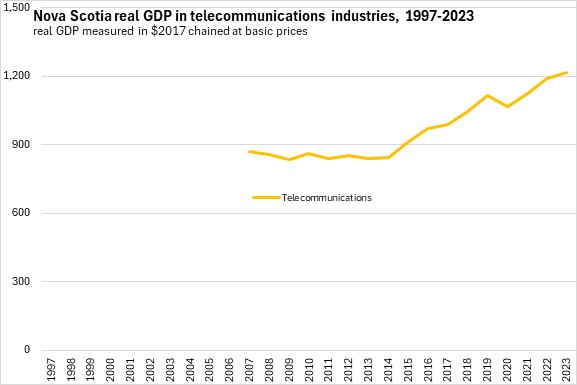
Among smaller industries in information and culture, there has been declining real GDP from radio/television broadcasting, newspapers and motion picture exhibition. There have recently been substantial increases in real GDP from motion picture and video industries outside of exhibition.
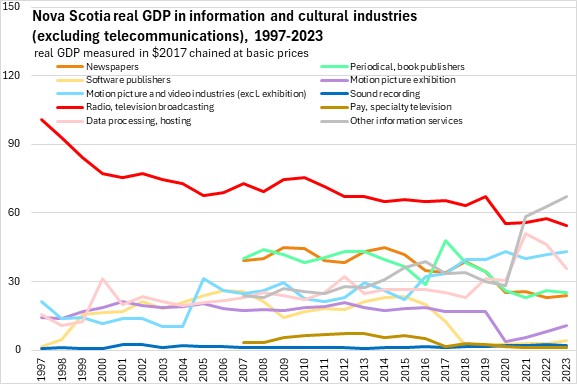
Real GDP from Nova Scotia banking and credit intermediation services has risen steadily since 2014 with the exceptions of 2020 and 2023. Real GDP from investment services and funds reported growth from 2009 before contracting in 2022. Real GDP from insurance carriers was flat from 2005-2017, then rising from 2018-2021 for contracting in 2023.
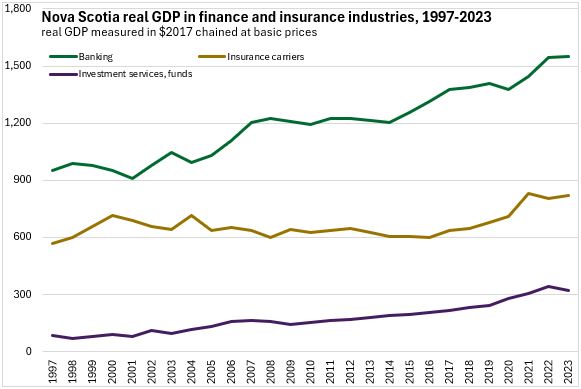
Real GDP by industry includes an imputed value for the real GDP generated by the housing services enjoyed by those who own the dwellings they occupy. This real GDP from owner-occupied dwellings has growth steadily and makes up the largest component of real GDP from real estate (even though it is never measured through an explicit housing services transaction). In contrast, the real GDP from leased real estate is measured explicitly and has also been rising steadily. Real GDP from real estate agents in Nova Scotia has declined since 2020.
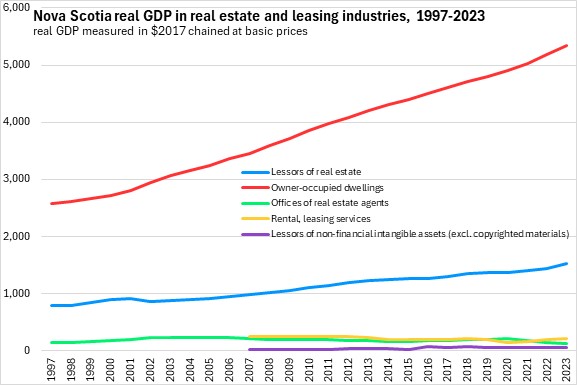
Professional and technical services in Nova Scotia accelerated during the pandemic, particularly for computer systems design. There have also been increases in real GDP for legal/accounting (except in 2020) and architecture/engineering. However, there have been steady declines in real GDP from company management in Nova Scotia (which is not categorized as part of professional/technical services).

After rising rapidly from 1998-2004, there has been a protracted decline in real GDP from "other administration support" industries, which includes call centres. Real GDP from services to buildings and waste management have been flat in recent years while there has been a gain in real GDP from investigation/security services. Travel arrangement services' real GDP fell sharply during the pandemic and has yet to post much recovery.
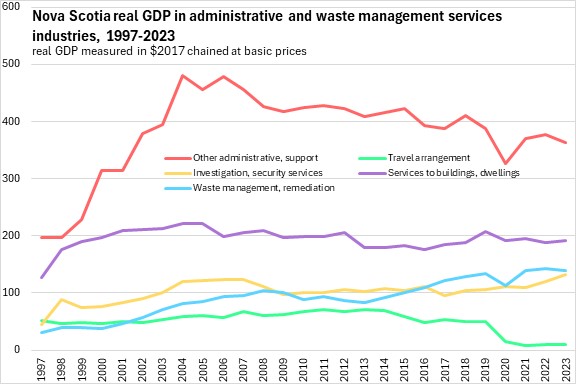
High-contact industries in arts/recreation and accommodation/food services exhibited the most severe contractions and rebounds during the COVID-19 pandemic. Traveller accommodations and amusement/recreation services have recovered to pre-pandemic levels of real GDP by 2023 while food services/drinking places had not.
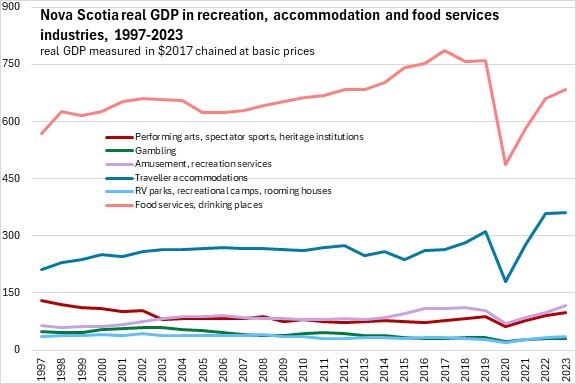
Among other services, there has been steady growth in real GDP from automotive repair. Like accommodation/food, personal care services (such as hair care) reported a sharp decline and rebound in real GDP during the pandemic and have yet to recover to pre-pandemic levels.
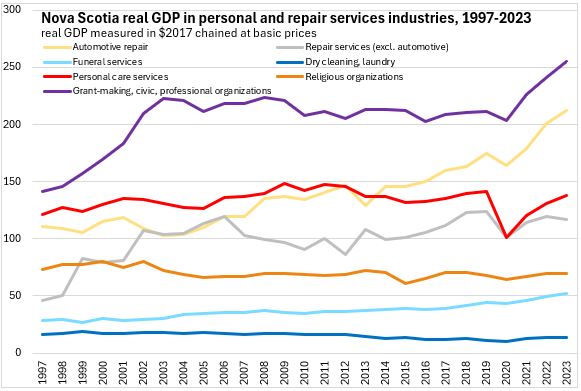
Public sector real GDP increased steadily from 1997-2011 before contracting in the next two years and stabilizing through 2017. Since 2017, there has been a mostly steady rise in public sector real GDP in Nova Scotia, with the exception of 2020.
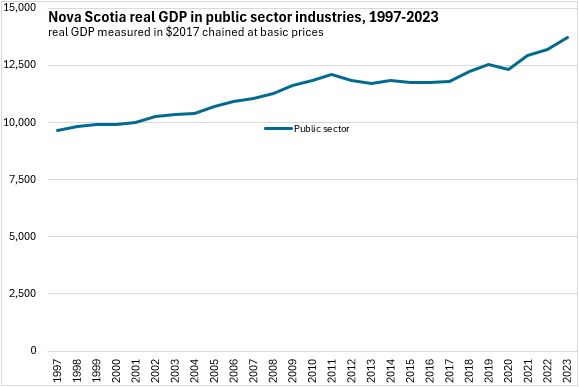
Nova Scotia's real GDP from education industries - which includes both public and private services - has increased largely on rising GDP from universities (along with elementary and secondary schools in since 2020).
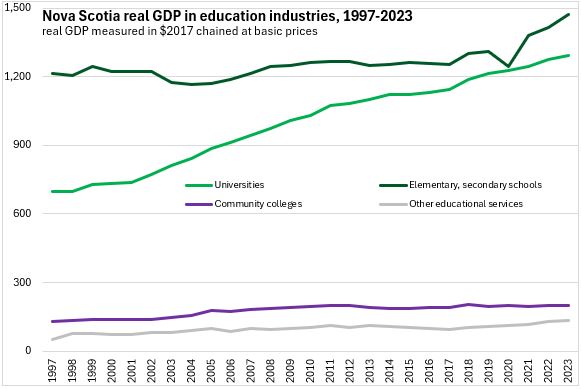
Real GDP from health care and social assistance (including both public and private industries) has been rising largely from hospitals and nursing/residential care facilities.
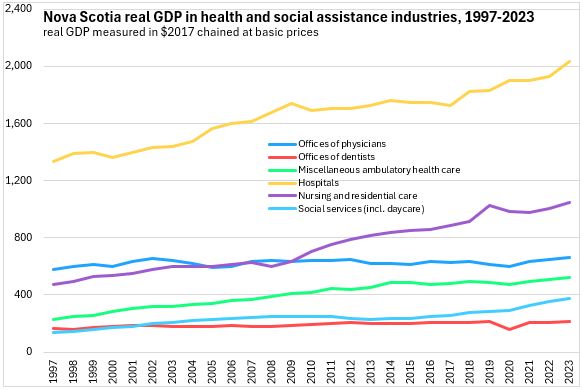
Within government services, there were notable declines in real GDP from Nova Scotia's defence services as well as the broader Federal government from 2011 through 2017. Real GDP from provincial government services contracted from 2013 to 2017. Since 2017, real GDP from Federal government and defence services have risen faster than real GDP from other government services in Nova Scotia.
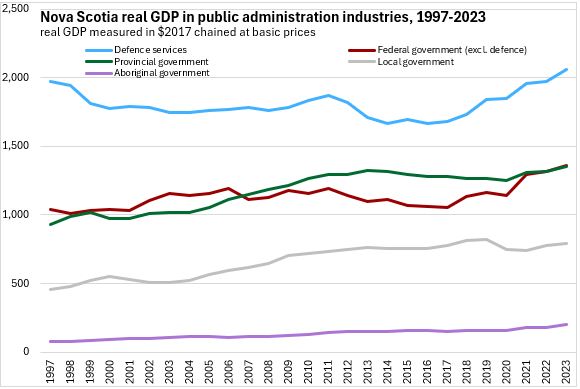
Source: Statistics Canada. Table 36-10-0402-01 Gross domestic product (GDP) at basic prices, by industry, provinces and territories (x 1,000,000); Table 36-10-0400-01 Gross domestic product (GDP) at basic prices, by industry, provinces and territories, percentage share
<--- Return to Archive